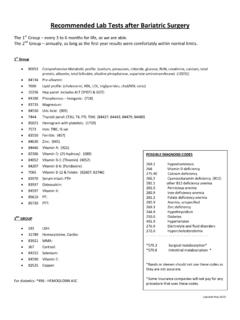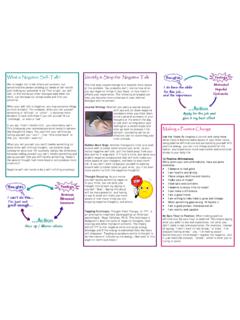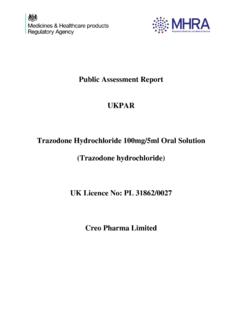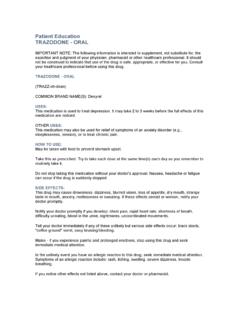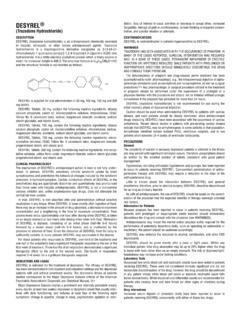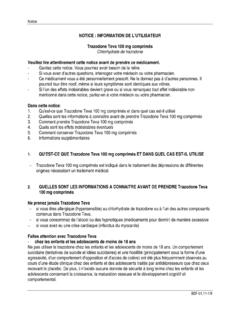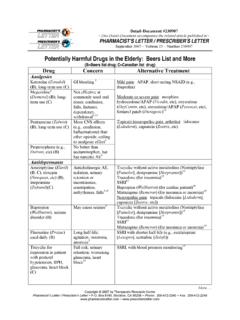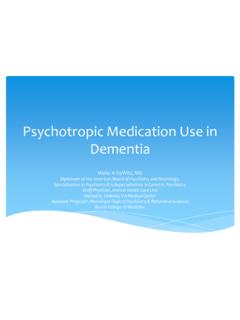Transcription of Dissolution of Common Psychiatric Medications in …
1 250 46:3, May-June 2005 Dissolution of Common Psychiatric Medications in aRoux-en-Y Gastric Bypass ModelJEFFS. SEAMAN, , , STEVENP. BOWERS, ,PATRICIADIXON, , LIBBYSCHINDLER, numbers of Roux-en-Y gastric bypass (RYGB) surgery patients have Psychiatric illnessesthat are in part treated with medication preoperatively, but there are no objective data to guidepsychiatric drug dosing postoperatively. An in vitro drug Dissolution model was developed to ap-proximate the gastrointestinal environment of the preoperative (control) and post-RYGB tablets were placed in the two environments, and the median calculated weights ofthe dissolved portions were compared. Ten of 22 Psychiatric medication preparations had signifi-cantly less Dissolution and two had significantly greater Dissolution in the post-RYGB environ-ment, compared with the control environment. The results suggest a need for an in vivo study ofserum drug levels after RYGB surgery in patients taking Psychiatric Medications .
2 Differences inthe pharmacokinetics of the postoperative RYGB patient may necessitate adjustments in dosing.(Psychosomatics 2005; 46:250 253)Received Feb. 26, 2004; revision received Aug. 4, 2004; accepted , 2004. From the Department of Psychiatry and Behavioral Sciences,University of Oklahoma Health Sciences Center, Oklahoma City, Okla.;and the Bariatric Surgery Clinic and Department of Clinical Pharmacy,Wilford Hall Medical Center, Lackland AFB, Tex. Address correspon-dence and reprint requests to Dr. Seaman, Department of Psychiatry,Oklahoma University, 10204 Green Valley Rd., Oklahoma City, OK73151; (e-mail).Copyright 2005 The Academy of Psychosomatic gastric bypass (RYGB) surgery hasemerged as a popular, last-option, but highly effec-tive method for weight loss in morbidly obese patients select the surgical option after having failedto achieve control over their obesity through other exhaus-tive measures.
3 One of the most commonly described mo-tivations of patients is to seek a decrease in the morbidityand mortality that is often associated with chronic, inter-vention-resistant with morbid obesity often have several othermedical problems, and extensive prescreening is warrantedto best prepare them for the surgery. Consistent with manycenters that offer this surgery, a preoperative psychiatricconsultation has been routinely completed at Wilford HallMedical Center. We found that a large number of patientselecting to have this surgery had comorbid Psychiatric ill-nesses, such as depression, anxiety, and posttraumaticstress disorder. Within this subgroup, many were takingpsychiatric Medications before the surgery. A chart reviewof the 74 Psychiatric consultations done in 2002 at WilfordHall Medical Center for preoperative RYGB patients notedthat 25 (34%) were taking Psychiatric Medications .
4 Thefive most Common Medications were venlafaxine (N 7),valproic acid (N 6), citalopram (N 5), sertraline(N 5), and fluoxetine (N 4).Management of these Medications peri- and postop-eratively can present unique challenges and currently isguided only by clinical judgment. There is scant literatureregarding Psychiatric illnesses and this population were unable to find any published research reports re-garding the management of Psychiatric Medications afterRYGB, except for a single case report on haloperidol clinical practice of the local surgeonshas been to recommend crushing all Medications , and tran-sitioning any sustained-release formulations to instant-re-lease formulations. Otherwise, Psychiatric medication ad-Seamanet 46:3, May-June 2005 post-RYGB have been made on a case-by-casebasis by the patient s outpatient , the RYGB patient has a unique digestivetract.
5 It begins with a nonacid producing gastric pouch of30 cm3, which empties within 60 seconds directly into theupper is almost no pepsin3and certainlyno active pepsin (at pH pepsin is inactive). It is as-sumed other digestive enzymes such as amylases, lipases,and various proteases should still be secreted in the RYGB patient because of intact enteral reflexes and hormonal ( ,secretin) are thus likely to besignificantly affected by these anatomic and chemical a starting point, we chose to investigate variabilityin drug Dissolution . We hypothesized that Dissolution ofpsychiatric Medications in a post-RYGB bench-top modelis either faster or slower than in a preoperative Dissolution fractions of 22 Common Psychiatric med-ications (listed in Table 1) were tested in experimental me-dia. Only instant-release tablet preparations were used. Themedia and manipulation of the media were designed toapproximate the gastrointestinal tract of a post-RYGB pa-tient and of a preoperative comparison patient.
6 Thus, twodissolution environments were environments utilized a preheated dissolutionmedium (lactated ringers at 37 C). The post-RYGB envi-ronment had a pH of ( intestinal ), and the controlenvironment had a pH of ( gastric ).5 Adjustment toreach the proper pH was made by micropipette addition ofhydrochloric acid (control model) or sodium bicarbonate(post-RYGB model), as needed. Lactated ringers with a pHof is a poor acid-base buffer and thus was easilyadjusted to the required composition was identical between themodels. Each 100 ml contained 600 mg of sodium chloride,310 mg of sodium lactate, 30 mg of potassium chloride,and 20 mg of calcium chloride. Milliequivalents per literwere 130 meq/liter for sodium, 4 meq/liter for potassium, meq/liter for calcium, 109 meq/liter for chloride, and28 meq/liter for lactate. Osmolarity was 273 milliliters of medium were utilized in 50-ml testtubes for each environment.
7 This approach approximatedthe 30-cm3size of the post-RYGB gastric pouch and thusthe upper limit of a jejunum chyme bolus in the RYGB patient. Simulation of bile and pancreatic secretions intothe gut was not done because of the added complexity ofincluding these features, but bicarbonate was used to in-crease the pH of the lactated ringers. Pepsin, which is pres-ent in a normal stomach but not in the post-RYGB gastricpouch, is not believed to affect drug the control model, noncrushed tablets were individ-ually added to the gastric medium for 60 minutes, andthe test tubes were placed on an orbital shaker (37 C) at100 rpm for the first 5 minutes, then at 50 rpm thereafterto simulate gastric motility. After 1 hour, the media-pillmixture was centrifuged at 3000 rpm for 15 minutes. Theliquid fraction was carefully removed by vacuum pipetteaspiration. Thirty milliliters of the neutral intestinal so-lution was then added to the tube with the residual tabletmaterial, and the pH was adjusted if needed to by ad-dition of bicarbonate.
8 The new mixture was exposed for60 minutes on the heated orbital shaker (50 rpm).After this second hour, the sample was again centri-fuged for 15 minutes at 3000 rpm, and the liquid fractionwas removed by diligent vacuum aspiration. Any remain-ing liquid was evaporated by placing the tubes back insidethe heated orbital shaker until no visible liquid no time did the temperature of the heating process ex-ceed 70 C, as the lowest melting point of any of the studymedications was that of trazodone at 86 pellet andtest tube were digitally weighed, and the weight was sub-tracted from the original weight of the test tube plus tabletto calculate the amount of the dissolved the post-RYGB model, Medications were crushedwith a mortar and pestle, as this preparation is used clini-cally with the RYGB population. The procedure was iden-tical to that for the control model, except the crushed tabletwas added to the RYGB medium (pH ) for 2 hours andspun on the centrifuge once at the end of 2 hours.
9 Thus thefirst 2 hours of gastrointestinal exposure was simulated inboth the control and the RYGB trials were conducted for each medication ineach of the two media. A sample size of three pills perenvironment provided 80% power to detect a very smalleffect size (effect size , about five standard deviations)between models. The sample size did, however, provide99% power to detect very large differences (10 standarddeviations). The alpha level was The independentvariable was the medium content (pH) and process as de-fined earlier (RYGB model versus control model). The de-pendent variable was the calculated quantity of tablet calculated weights of the dissolved portions werecompared between the control and the RYGB models forDissolution of Medications After Gastric Bypass252 46:3, May-June 2005 TABLE 1. Weights of Dissolved Portions of Psychiatric Medications in Standardized Dissolution Test Models of the GastrointestinalEnvironments of Preoperative and Postoperative Roux-en-Y Gastric Bypass (RYGB) PatientsPreoperative (Control)EnvironmentPost-RYGB EnvironmentMedicationDose (mg/day)Median weight ofdissolved portion (mg)%aMedian weight ofdissolved portion (mg)%apbAntidepressantsAmitriptyline7580 286021 , carbonate3001303528075 to original pill U medication .
10 A Student s t test for each drug was ini-tially planned for the comparisons between the two first analysis, however, the parametric quality of thedata could not be confirmed. For this reason, a nonpara-metric test was selected (Mann-Whitney U), and mediansrather than means are reported. Two-tailed significance lev-els were chosen, as Dissolution differences were expectedto vary in direction within the of the 22 medication preparations were found todissolve differently across the two environments. Ten ofthe 12 dissolved more in the control model, and only twodissolved to a greater degree in the RYGB model. Althoughnot reported, variability within each sample of three pillswas minimal. In no case did a value stray beyond 10%difference from the median weight change. (Variabilitydata are available from the authors.) We chose not to reportstandard deviations, as we could not confirm that the datawere parametric.
